Learning how to write SEO friendly blog posts is one of the best things you can do. Don’t know how to write them? Here’s a 10 step process on exactly how to do that.
After taking several courses on SEO, and writing SEO articles for my blog and clients, I’ve learned a few things about SEO.
There’s still so much remaining, but I’ve learned how to write an SEO friendly blog post.
I’ve figured out a process that works. And in this post, I’ll show you exactly how to research, plan, and write an SEO optimized blog post from scratch.
Want to save this pin for later?
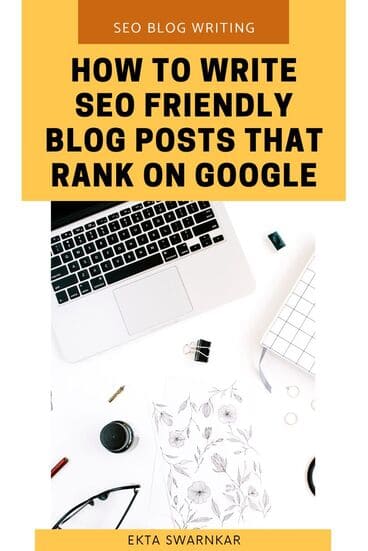
This post may contain some affiliate links that is I may earn a small commission at no extra cost to you that I would use to maintain this blog. Thanks for understanding.
If you already know the importance of SEO optimized blog posts, click here to jump to the “how to.”
Otherwise, let’s establish some context first.
Why is writing SEO friendly blog posts Important?
I want you to check out these two stats. The first one is a graph on ROI per $1 spent. SEO brings $22.24 for every $1 spent.
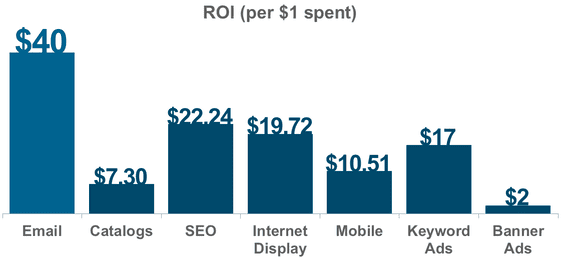
Now the second one. Google owns 86.6% of the search engine market.
So what do we understand?
If businesses focus on Google SEO, they can get more than 20 times more in returns than spent.
But here’s why SEO is better than email marketing.
SEO brings long term results. Email marketing brings instant and one-time results.
The SEO friendly blog post you publish now will drive traffic for a long time. But, an email sent is effective only once.
Smart businesses know it’s not about which is better. They use both SEO and email marketing strategically.
But, here’s a more interesting question.
How is writing SEO friendly blog posts helpful for you?
If you’re a blogger or a copywriter who works for clients or both (like me), this is the best skill you can learn. Here are the reasons why:
Drive long term, free organic traffic
A big part of SEO is about writing SEO friendly content. So, if you can write SEO articles that rank on Google, you can drive free traffic to your or your clients’ blogs for a long time.
Build brand authority
In terms of brand building, SEO helps in two ways.
- The more you rank on Google, the more people know about you, and the more business opportunities you get.
- The more you rank on Google, the more Google trusts you, the easier it is to rank for more keywords, and the better your brand authority.
Sell SEO services
Smart businesses know the importance of SEO. So, if you can prove that you’re a brilliant SEO writer, they will pay you top prices to help them grow. For example, Ryan Robinson built his career by focusing on SEO. He now creates SEO strategies for brands like LinkedIn, Zendesk, etc.
If you start writing SEO friendly blog posts and keep improving, you can take your career to the next level.
I’ve shown you the possibilities, and now the next logical step is to learn how to write SEO-friendly blog posts.
How to write SEO friendly blog posts: 10-step process
My SEO blog writing process involves three phases.
- Research phase
- SEO writing phase
- Marketing phase.
Each of them is crucial, so give it enough time.
Let’s begin with the research phase.
Step 1: Find the right Keyword
Almost half of your SEO success depends on finding the right keyword to optimize your blog post.
Why find the right keyword? And what is the right keyword?
Many (short tail) keywords require a lot of effort but don’t get you the results. Only some (long tail) keywords require little effort and rank on Google quickly.
So, the right keywords are those long tail, low competitive keywords.
If you’re writing for a new website (with low domain authority), targeting short tail keywords is a waste. You’ll never rank for these terms because high authority sites (currently better than yours) rank for them.
The best way to find keywords is to use a keyword research tool. I use SEMrush to find keywords.
Suppose I want to write a guide on creating an email list. So on my SEO dashboard on SEMrush, I will go to the Keyword Magic Tool and type the term “start an email list” on the search bar.
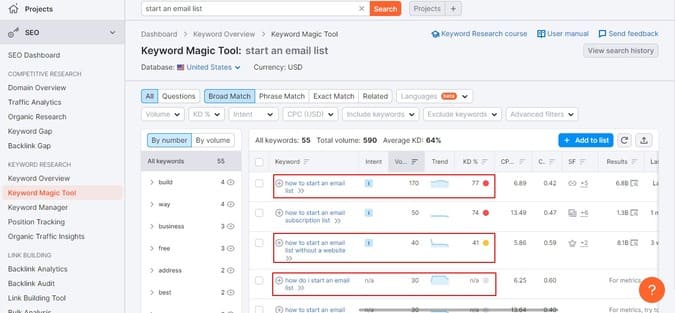
I’ll get different types of keywords.
- “How to start an email list” with a monthly search volume of 170 is a difficult keyword to target (SEO difficulty 77) – not the right keyword to target.
- “How to start an email list without a website” with a monthly volume of 40 is an average keyword to target (SEO difficulty 41) – good for websites with high DA.
- “How do I start an email list” with a monthly volume of 30 is a good keyword to target (SEO difficulty zero) – good for low DA websites (0 to 20)
I can also use filters to get specific keywords for my blog. For example, I found this keyword by setting filters keyword difficulty to “possible” and search intent to “informational.”
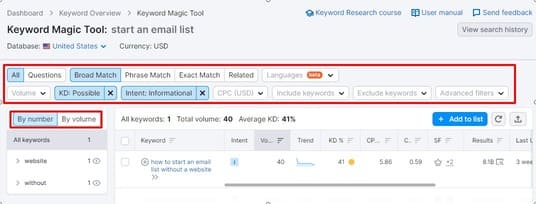
Similarly, you can use other filters to extract long tail keywords with easy keyword difficulty and enough search volume.
Each post should have one main keyword. But it’s good to find a set of 4 to 5 keywords. These keywords should be similar to the target keyword in terms of intent but can have different words.
For example, “how to start an email list” and “how to build an email list” are different keywords with the same intent.
Learn how to conduct deep keyword research here.
Step 2: Analyze SERPs
You’ve found a few keywords. But you need to validate them to see if you can actually rank for these keywords.
So, how do you verify your keywords? By analyzing SERPs.
I’ll search each keyword on Google one by one. Then I’ll see the domain authority of the top ten search results. If I get at least one ranking website closer to my website’s DA, then I have a chance to rank for this keyword.
To find out the domain authority, install the free Ubersuggest Chrome extension.
Let’s take the example of “how do I start an email list” on Google.
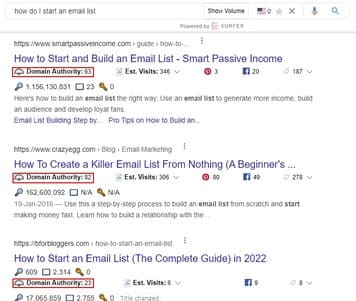
The Ubersuggest chrome extension will show these extra details below every listing. As you can see, the top ten results have one site with DA 23. This site’s DA is nearly equal to mine.
That means it is a good keyword for me to target.
So, that’s how you find an easy-to-target keyword.
Step 3: Determine your blog post length
Is blog post length a ranking factor? According to Google, it’s not.
But a recent Backlinko study states that long-form content attracts more backlinks and social shares.
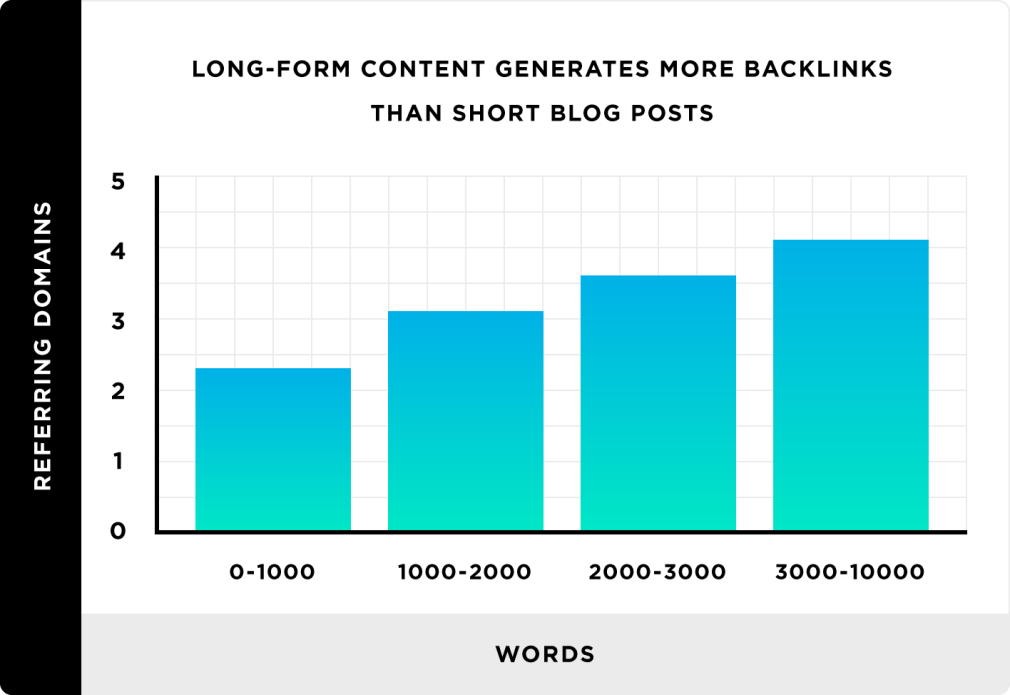
While they were not sure why Google prefers long-form content, both backlinks and social shares give that initial boost to get on search results.
Your goal is not to fill up a “word count” with fluff but to write detailed and better content than currently ranking. Having a rough idea about the word count will help you plan content better.
So, how to determine the blog post length?
One way is to install the free SEO surfer Chrome extension. It will display a word count below each listing.
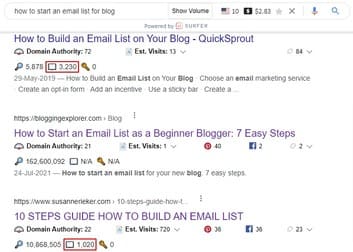
You can use the extension to determine the blog post length. To learn more ways to find an ideal blog post length, check out this blog post.
Step 4: Create a blog post outline
The next step is to create a blog post outline. Something that will help you outrank the current listings.
Google’s priority has always been clear. It wants to deliver the best answer to the user’s questions.
If you want your blog post to be the best answer, you first need to understand the question.
Skim top 10 results
To understand the reader’s problem, you should analyze the search results for the target keyword.
Why? Because the posts that are currently ranking are the best answers. So, your job is to analyze these results and create a better version of them.
Let’s understand with an example. I would type my keyword “how do I start an email list” on the Google search bar to get these results.
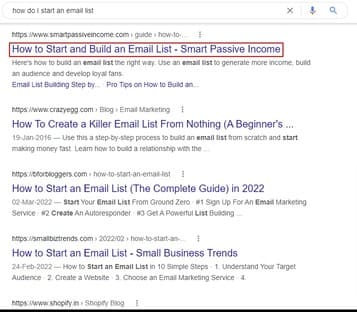
The boxed blog post is first, so Google thinks it’s the best answer.
I will click on each of these posts, go through them and try to figure out the topics they missed or didn’t explain well.
That’s how I will create a better outline that covers all those missing topics.
Use the Answer The Public tool
Another way to add trending questions to your blog post outline is using the free Answer The Public tool. It shows the most asked questions around a topic.
So for our example, I will type “how to start an email list,” and here are the questions generated by the tool.
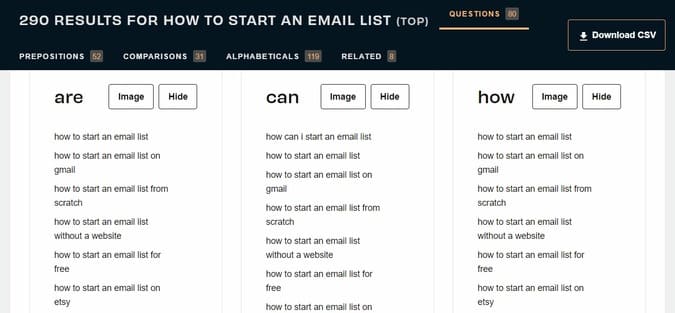
Now, skim through all the topics and add those that you think will add more value to the article.
Get topics from the “People Also Ask” section
Another way to add more to the article is by using the “people also ask” section.
Why should you use it? Because it’s directly Google telling you that these are popular questions people are asking around the topic.
Let’s try it with our example. I will search for “how do I start an email list,” and here are the questions I get.
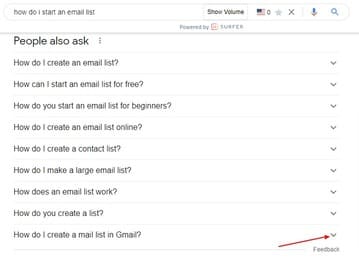
By clicking on the little drop down, more questions will show up.
I’ll add all those questions that I think will add more value to my blog post.
These methods will help you create a better outline. Here is a more detailed guide on how to create the structure of a blog post. It doesn’t have to be too much, just better than currently ranking ones.
From here, we move on to the second phase, which is writing.
Step 5: Write your first draft
Now you’re ready to write your first draft.
But before you start writing, try to think through the eyes of the reader. Find out answers to the questions like
- Why is he searching for this question?
- What’s his biggest struggle?
- What does he want to achieve?
After that, you will be better off serving the search intent.
Now, you’re ready to write the first draft.
I generally optimize my blog posts for SEO as I write them. And I recommend you do the same. Because it’s easy, and there isn’t much you need to do to optimize a post for SEO.
Just focus on these things.
Install an SEO plugin
Installing an SEO plugin helps in following the best SEO practices.
I used to use Yoast SEO. Then I installed the RankMath plugin. And it’s great. I have the RankMath plugin installed, and here is how it looks.
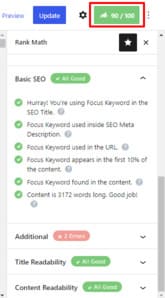
It will show the blog post’s SEO score based on its SEO friendliness. A green check mark appears when you follow an SEO practice.
What’s great is that RankMath has an in-built Content AI tool that analyzes your blog post to give specialized SEO recommendations to help it rank better. All you have to do is enter your keyword.
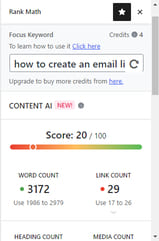
It shows keywords to use to add more signals to the post. The more similar keywords the search bots find, the better they will understand your blog post and the higher your search rankings.
Check out the Rank Math plugin here.
After installing the plugin, make sure to follow these practices to write SEO friendly blog posts.
Write SEO friendly blog post headlines
The blog post headline is one of the places to optimize because search bots use it to find about your post content. And readers read it to decide whether or not your blog post is worth reading.
So, you have to write blog post headlines that:
- Tell search bots what the blog content is about
- Encourages readers to click on it and read the content
Writing SEO friendly blog post headlines is like following a checklist. You just have to make sure you are doing these things:
- Keep it up to 70 characters long.
- Include the main keyword (preferably in the beginning)
- Add curiosity generating elements to encourage a click.
Now, that’s a lot to do in 70 characters.
If you’re targeting a long tail keyword, there isn’t much you can do about it. But crafting witty titles is totally doable. For example, check out this title by Jacob Mcmillen.
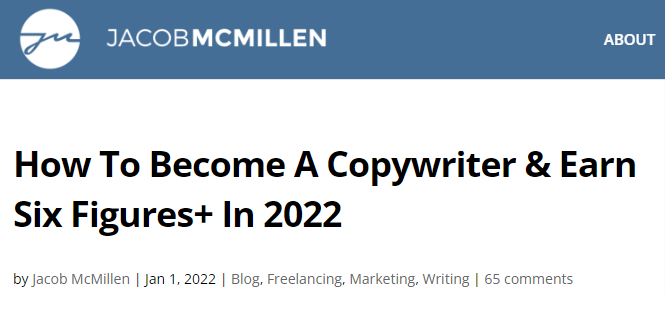
It follows all the best practices:
- Only 54 characters long
- Used the keyword “how to become a copywriter”
- Encouraging readers to click with the phrase “earn six figures+”
Your headline can be simple. It just needs to be SEO optimized and attention grabbing.
Check out this post to learn how to write blog post headlines step-by-step.
Use the main keyword in top level subheadings
Just like the headline, optimize the subheadings. Search bots scan subheadings too to understand more about your content.
For subheadings, you don’t have to keep them within 70 characters, but you must follow the other two practices.
- Add the target keyword to your top level subheadings (don’t stuff keyword to all the subheadings)
- Make them engaging
Use the main keyword in the first paragraph
Another place to add your main keyword is in the first paragraph (or first 100 words). For search bots, it’s like confirming that what’s told in the headline is taught in the content.
That’s right. You don’t have to stuff keywords after every 500 words or follow a keyword density. You just have to use the right keywords in the right places.
It’s easy to use the target keyword at the beginning of the article to build context. For example, see how Jacob uses context to use the keyword in the first 100 words.
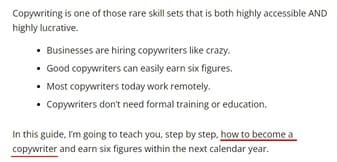
Add relevant internal links
Adding internal links will help you get other pages of your site indexed. Plus, it’s better for user experience.
When you’re talking about something that is beyond the scope of the article (or you already have a well written post) but know it can help readers, you should add an internal link to give them an option to check out that post.
You might have noticed above that I linked to some guide posts. Those were all well planned internal links.
Add high-quality external links
High-quality pages link to other high-quality pages. Adding external links is like telling search bots to categorize your page with these other high-quality sites.
But another reason is to cite credible sources. If you’re stating a fact or research statistic, it’s always a good idea to link to authoritative sites instead of some crappy site.
If I mention statistics in my posts, I take it from a reputable website like Statistica. For example, this stat by Statistica shows that 77% of mobile searches were zero-click searches.
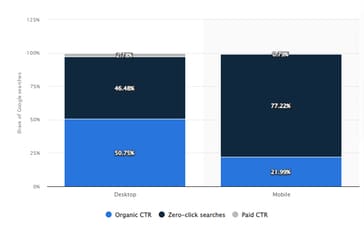
Why did I link it here? Because I know they conduct experiments and surveys to find results. And Google trusts Statistica.
Write keyword optimized meta description
Meta descriptions are also critical in helping search bots learn more about your blog post. So, the best practices for writing SEO friendly meta descriptions are:
- Keep it 160 characters short.
- Use the target keyword.
- Make them enticing to encourage a click.
Using the RankMath plugin, you can optimize the meta description here.
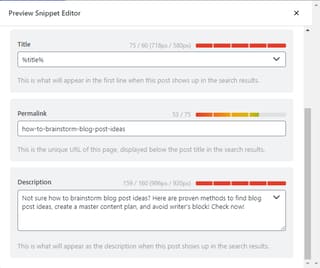
Optimize your blog post URL
The last place to use your keyword is in the blog post URL.
But there’s an interesting pattern I noticed. The results are not confirmed as I’m still testing it.
I’ve noticed that blog posts with URLs using the same keyword get indexed faster. They start ranking quickly too.
For example, I published this blog post with the title “how to brainstorm blog post ideas in your SEO content strategy” and used the target keyword in the URL – https://ektasw.com/how-to-brainstorm-blog-post-ideas/.
In only a week, it’s ranking for 12 keywords. And it includes the target keyword also.
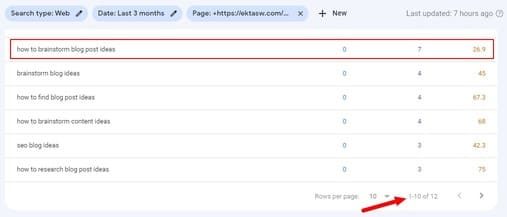
Writing SEO friendly blog posts is a bit strategic. By following these practices, you’re already optimizing the blog post without doing much.
Now go ahead and finish your first draft.
You might be wondering how to write a blog post with keywords?
Don’t worry too much about using the main keyword. Just find places where you can use it naturally. If it isn’t possible, use the other keywords. Or don’t use them at all.
SEO friendly posts that rank are not keyword based. They’re value based. So, ensure that you add enough value that solves the readers’ problem.
Step 6: Edit your blog post
Often the first draft you write is not its best version. Heavily edited posts are great SEO friendly blog posts. So, half of the job is still left.
When you have to edit the first draft, it’s best to read it as a reader. This way, you’re more likely to find mistakes.
Editing is all about making it easier to read. In your first draft, you will find many parts difficult. So go ahead, give your draft many reads and fix these issues:
Break long paragraphs
Shorter paragraphs are easier to read. They motivate the reader to continue reading.
Think about it, which one would you prefer to read, a wall of text or a page with a bunch of sentences?
You know the answer.
Simplify sentences, if needed
You will also find that many sentences are difficult to read. How? Well, it’s because you can’t read them in one go.
So, find those sentences and break them into shorter ones. Either use simple words or delete phrases – just make them easy to read.
You can use bold, italics, and underline to emphasize important words.
Fix common errors
Simple grammar mistakes aren’t something that will damage your career. But it’s better to have fewer grammar errors.
Using a tool like Grammarly, you can fix these mistakes.
Add optimized images with alt tags
Again, readers won’t stay long if you give them a wall of text to read. One smart way to add more flavors to your content is to add images.
Do you know images also help in boosting SEO? Yes, when optimized correctly, images can also bring traffic.
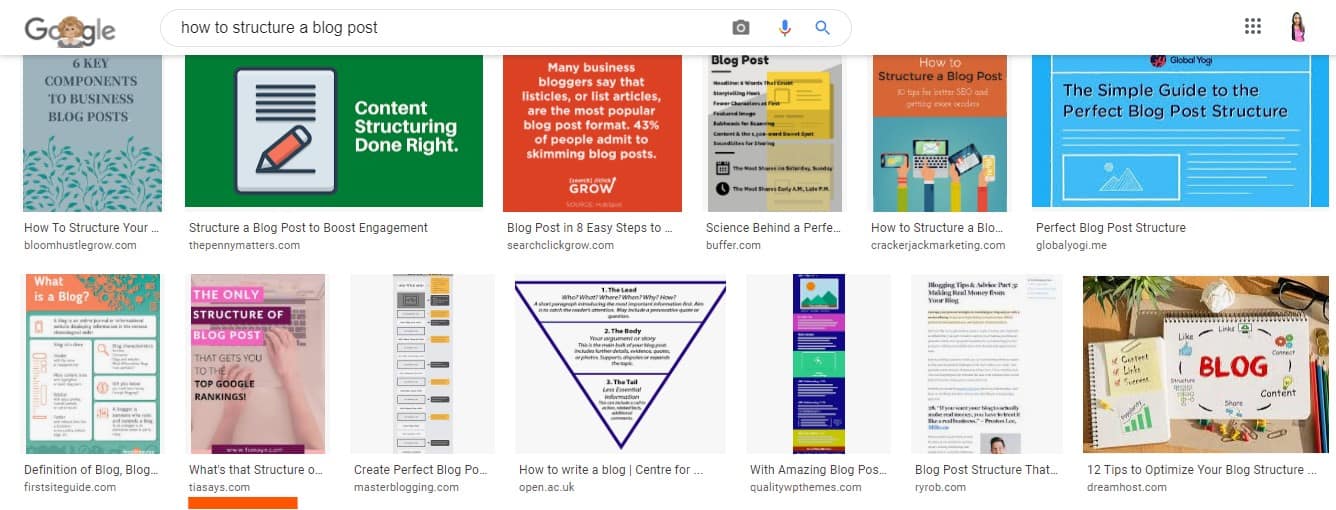
Here are the best image SEO practices to follow:
- Compress images using a plugin (ShortPixel)
- Add keyword optimized, descriptive alt text.
- Add descriptive image file names.
Find out all of the best image SEO practices here.
Adjust the structure, if needed
You’ll notice that the outline you created before writing the first draft was not the best.
You might want to adjust, delete or add new sections.
Improve readability
Lastly, make sure that the article is flowing well. Add conversational tone, transition words, connect sentences, humor, etc. to make the blog post engaging enough to read.
After you’re satisfied, give your SEO friendly blog post some time, then a quick read, and then hit the publish button.
But wait… work isn’t over yet.
SEO has evolved and so only publishing a blog post won’t make it rank magically on the first page.
For that, it needs an initial push. We are talking about the third and final phase: the marketing phase.
Step 7: Add a link to older posts
The first thing to do is to make the post discoverable to search bots. So, we will add the newly published post’s link to old blog posts. This way, you will pass the old posts’ link juice to the new one and increase your chances of getting indexed.
Step 8: Submit the URL to Google Search Console
After you’ve added some internal links, submit the new URL to Google Search Console to get it indexed. So, open your Console account. Now, click on “URL inspection” or paste the URL into the search bar.
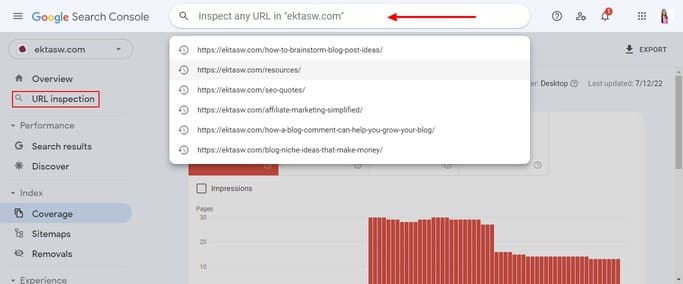
If Google has already indexed the URL, you will see the “URL is one Google,” but if it’s not, you will see the “URL is not on Google.”

In both cases, you can click on “Request Indexing” to submit it.
Step 9: Promote your blog post
For search bots to analyze the performance of the new blog post, you will need to put it in front of readers. Google will then use other ranking factors (including user behavior) to rank it accordingly.
Send to your email list
Every time you publish a new blog post, share it with your email list.
Your email subscribers are interested in what you offer. They want to hear more from you. So, they are more likely to engage with your blog posts.
The easiest way to send an email is to tell them why you published the post, what they will learn from it, and its link.
Don’t have an email list yet? Here’s a step by step process to create an email list for your blog for free.
Share on social media
Then you would also want your social media followers to read your new post. So, share a link to your post with great headlines and images to get more engagement. You can also ask your fellow bloggers to share your post.
Build backlinks
Since this post is about writing SEO friendly blog posts, I haven’t covered backlinks in detail. But backlinks are one of the top deciding factors in ranking a post.
So, you must build as many links as possible. The Ubersuggest chrome extension shows the number of referring domains of each site listing. Use this data to create your backlink campaign.
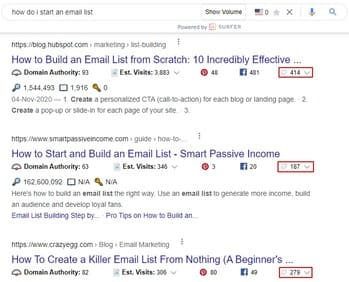
My favorite way to build backlinks is guest blogging. Here’s a step-by-step guide on guest blogging for new bloggers.
Step 10: Add fresh content regularly
Lastly, you must always keep your content fresh. The top ranking posts are updated because Google wants to provide new information to its users. Keep adding a fresher perspective to your blog post.
Conclusion: How to write SEO friendly blog posts?
So this is how to write SEO-friendly blog posts using a 10-step process.
Optimized content is a big part of SEO, but it’s still not all. That’s why I have created this 35+ point SEO checklist that includes both on-page and off-page parameters.
Tell me, how do you write SEO friendly blog posts? Which keyword research tool do you use?
More resources to check out:
- Best keyword research tools for bloggers
- Appsumo’s best SEO tools for writers
- Best free SEO courses for bloggers
- Best SEO quotes & tips for bloggers
I hope you found this post helpful. Follow me on Twitter, Facebook, and LinkedIn. Or why not subscribe to my newsletter and get blogging and writing tips straight to your inbox weekly?






Great post! I think I am getting a bit better at SEO, but there is so much to learn. Thanks for sharing this valuable information!
SEO isn’t difficult but a big topic that’s why many bloggers are hesitant about learning it. Thanks for reading Tiffany.
this guide is gold for me! thanks for sharing all this precious info!
Hopefully Claudia, this SEO guide will help you write posts that get ranked.
So much great info on SEO- thank you!
This is a really useful post. Thanks.
Thanks for all the tips. SEO is hard to figure out but this is a good starting point.
SEO plugins are a great. They totally have taught me SEO and helped me start getting traffic through SEO.
Absolutely! When I started SEO writing I was dependent on these SEO plugins only.
Great post, I think I’m getting better at SEO since I got the Yoast SEO plugin
Yes, the Yoast SEO plugin makes SEO sure easy and effective.
Simple, detailed, and informative. Love this post! I like how you covered all the aspects of SEO.
Thanks Sumedha! Loved your comment. Yes, most beginners don’t start SEO writing because they think it is difficult while it is not.
I love the way how you explained this topic. I’ve already read a number of articles on this topic but I’ve found your content the best. Super engaging & informative as well!
Thanks Rasikha! Loved that you liked it. This is a beginner’s guide so I tried to make SEO writing as easy as possible for new bloggers.
These are fabulous tips. I definitely need to optimize more of my older posts that rank around page 10+ on Google. It is hard to do but could be well worth it if I can push them further toward result 1! I appreciate all the good info!
Thanks Shyla, Yes, optimizing old posts with the latest SEO is one of the smartest tricks to not only climb higher but also get more organic traffic.
wow! this post was very enlightening! 🙂 i’ve been trying to focus on evergreen content so i can promote it all year long. there’s so much to learn with SEO but I’m getting there! thanks for sharing!
Thank you for reading. I appreciate it.
Sadly I don’t have SEO due to the WP plan I’m on and I’m really unsure about going self-hosted since I don’t know what I’m doing LOL
I found your blog post very helpful despite not having access to SEO tools. I’m learning so much and things are just starting to make a bit more sense. Thank you for your clear and insightful tips! Much appreciated!
Thanks Hilary, so glad you find these tips useful. I hope you learn soon and start working on your blog SEO. Let me know if you need any help. Good luck!
SEO-friendly blog post ranking can be increased by implementing keywords in the article.